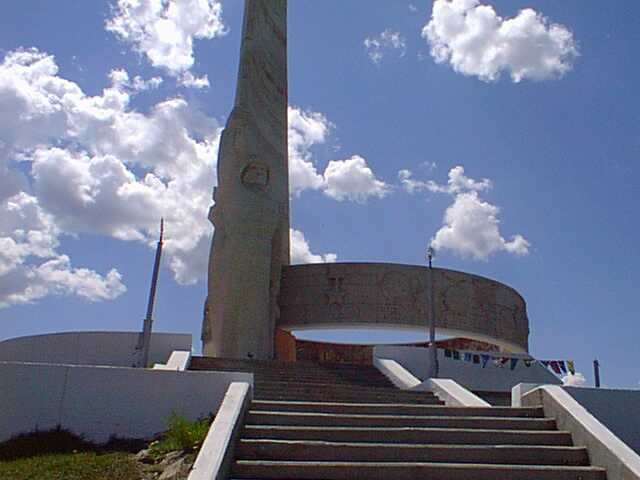
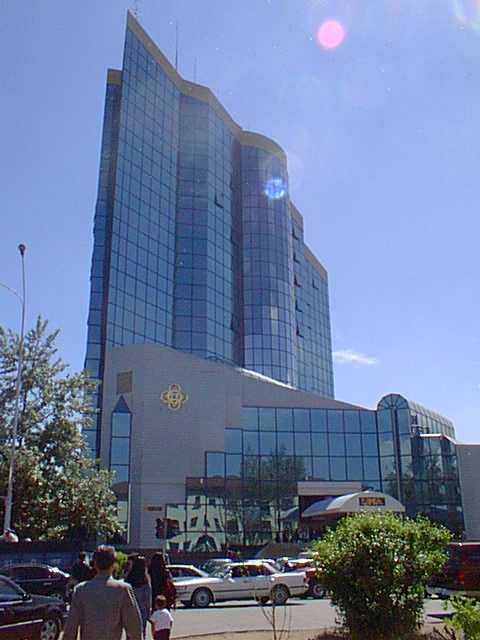


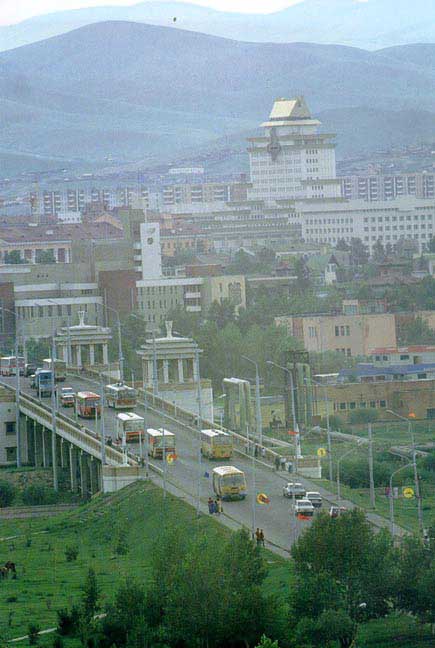

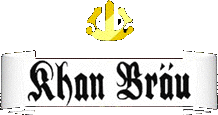
|  |

THE STATE ACADEMIC OPERA AND BALLET THEATER
The Mongols are a people with a rich cultural heritage. There are many different and very unique art-forms that are indigenous to Mongolia, and many Mongolian artists excel in non-traditional areas of the performing and aesthetic arts.
Ulaanbaatar's arts community reflects this rich heritage with its many offerings of performances, exhibitions. Mongolia's State Opera Theater is a shining example of this rich heritage.

THE NATIONAL ART GALLERY
Since its establishment in 1989, the Mongolian National Modern Art Gallery has consolidated its position as one of the foremost art institutions in Mongolia, initiating and presenting significant national and international exhibitions by maintaining a strong commitment to Mongolian visual art from the year 1921 and to the different international projects and art exhibition exchanges. The Gallery is ideally located in the heart of Ulaanbaatar off Sukhebaatar square.
The Gallery continues to demonstrate, through its significant collection of Mongolian Modern Fine Art, a research collection of over 4000 items. These include traditional paintings, fine art, sketches, sculptures and traditional handicrafts along with a database of more than 1500 Mongolian artists. Conferences and education are important components of the Mongolian National Modern Art Gallery's programs. Only 10 per cent of its holdings are being displayed in its exhibition hall.
Every year, the Gallery holds a series of art exhibitions of both domestic and foreign artists and from both external sources as well as from its own collection.

Bayangol Hotel of Mongolia is situated in the heart of Ulaanbaatar city, capital of Mongolia.
With over 200 rooms Bayangol hotel is one of the oldest and the most experienced hotel of the Mongolian tourism industry. You will find anything quite like this that matches in granduer, comfort and style in Ulaanbaatar.
Flagman of the Mongolian tourism industry Bayangol hotel boasts with its biggest restaurant in the city, luxury rooms, good services. Bayangol hotel receives more than 40 per cent of the total organized tourist traffic to Mongolia and extends its services to the Embassies and International Organizations both in Ulaanbaatar and abroad. Management of the hotel wishes you a nice stay with us.

|
|  |
 |
 |
 |
 |

 


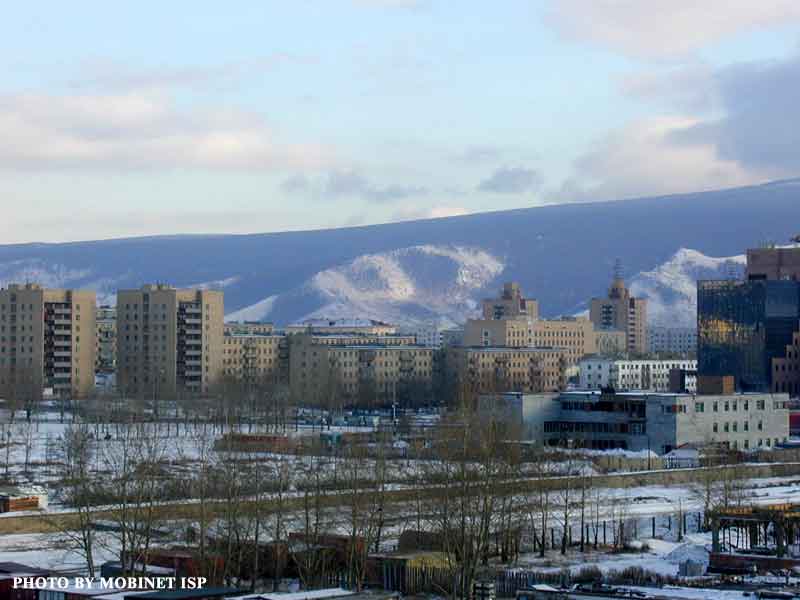 
MUSEUMS OF ULAANBAATAR
Natural History Museum
Here you will get an overview of the geography, flora and fauna of Mongolia. Of special interest is an outstanding collection of dinosaur bones, which were found in the Gobi Desert. First sensational discovery of dinosaur bones were made by the expedition of adventurous American, Roy Chapman Andrews back in 20s. Since then, expeditions from Russia, Poland and recently from the USA and Japan are coming regularly. The museum is located just across the street from the Government House.
National History Museum
Set up recently, the museum occupies the building of the former Museum of Revolution. The museum offers the richest collection on the history of Mongolia, from Stone Age to modern times. It allows to retrospect the unique culture of horse riding steppe nomads and their lifestyle. The exhibition contains many artifacts of traditional handicrafts and arts, military equipment and arms of Chinggis Khaan warriors. The museum is located on the corner of the downtown Suhbaatar Square.
Gandan Monastery
Built in 1840, it is the most important monastery in Mongolia. It is easily seen north west of the city center. In the past it was one of the main Buddhist centers in Asia having two dozens of chapels and famous for its library collection of religious documents and the typography.
The monastery was severely damaged during the repression of 30s and only few building remained among them a chapel for 20 meters high statue of Megzhid Janraisig god erected in 1911 as a symbol commemorating the Mongolia's independence. During the WW II the statue was taken to Russia to be used as scrap metal for shells. In 1990 the statue was rebuilt with nation wide donations.
Have a $ 5.00 bill ready if you would like to take picture of this restored statue. The Gandan Monastery is the central place for major religious ceremonies and festivities, including Tsam Dance, a theatralised performance. The monastery has presently about 150 monks and a Buddhist School.
Fine Arts Museum
This museum is dedicated to paintings, religious arts and artifacts. You will find a wonderful collection of archeological artifacts from Hun period (III-II centuries BC) and panel embroidery.
It houses the largest tanka scroll (Buddhist embroidery tapestry) in Mongolia, but the museum premises are not spacious enough to display this 36 meters long tanka. The museum also has two unique Tsam Dance masks lavishly decorated with 15,000 and 5,000 pieces of deep purple corals. The museum is on a five minutes walking distance east from the Suhbaatar Square.
Winter Palace of Bogd Khan
This is the only remaining palace out of four residences where Bogd Khaan, the last Mongolian ruler, resided. This palace now displays the collection of personal belongings of the last Khaan and his wife. The museum offers a wide variety of Buddhist arts.
Special attention attracts by paintings by Marzan Sharav depicting with a slice of humor and irony scenes from the everyday life of Mongols in the turn of this century.
The Bogd Khaan was known as a true lover of nature who spent tremendous amounts on setting up large gardens with small ponds and boats. The palace zoo had even an elephant and a giraffe. He also collected staffed animals, some of which are exhibited.
Manzushir Monastery
Just 39 km southeast of Ulaanbaatar on the road toward Zuunmod is a monastery that you will not want to miss. The temple is nice and the view is spectacular. The monastery sits on the edge of a cliff overlooking a beautiful valley with creeks and granite boulders.
The monastery was established in 1733 and has had 21 chapels. Buddhist monasteries served as the centers of education, arts and various other disciplines. And among them Manzishir was famous for its school of philosophy and logic, attracting priests from as far as India coming for theological debates. In winter of 1938 the monastery was completely destroyed and the area eventually turned into a recreation zone.
Choijin Lam Temple Museum
This small monastery located in downtown was built on the turn of this century by the decree of the Bogd Khaan for his younger brother. This is one of few Buddhist monasteries that survived destruction during 1930. By irony, the communist powers decided to set up an anti religious center and the Choijin Lam Temple was picked up as its headquarters.
The museum contains precious examples of Buddhist art including the paintings by Ts. Zanabazar, a renowned religious reformer and great artisan of 17th century, as well as colorful masks for Tsam Dance ceremony embroidered with corals, bronze statues of gods in erotical poses, silk tankas and many other artifacts.
these informations are copied from the www.mongoliatoday.com |
 |
|
|